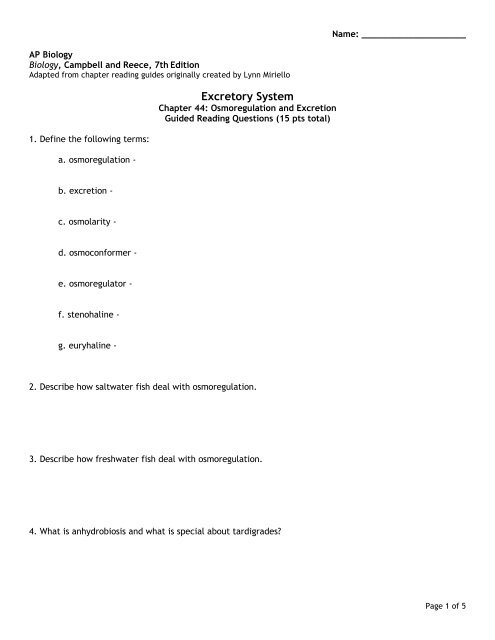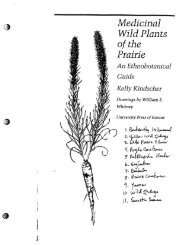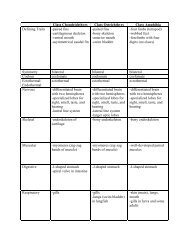Excretory System Reading Guide
Excretory System Reading Guide
Excretory System Reading Guide
Create successful ePaper yourself
Turn your PDF publications into a flip-book with our unique Google optimized e-Paper software.
AP Biology<br />
Biology, Campbell and Reece, 7th Edition<br />
Adapted from chapter reading guides originally created by Lynn Miriello<br />
1. Define the following terms:<br />
a. osmoregulation -<br />
b. excretion -<br />
c. osmolarity -<br />
d. osmoconformer -<br />
e. osmoregulator -<br />
f. stenohaline -<br />
g. euryhaline -<br />
<strong>Excretory</strong> <strong>System</strong><br />
Chapter 44: Osmoregulation and Excretion<br />
<strong>Guide</strong>d <strong>Reading</strong> Questions (15 pts total)<br />
2. Describe how saltwater fish deal with osmoregulation.<br />
3. Describe how freshwater fish deal with osmoregulation.<br />
4. What is anhydrobiosis and what is special about tardigrades?<br />
Name: ____________________<br />
Page 1 of 5
5. What are transport epitheliums?<br />
6. What are the three forms that animals use to dispose of nitrogenous waste?<br />
7. Use the diagram on the right to label and define filtration, reabsorption,<br />
secretion and excretion – be very clear on their meanings.<br />
8. Contrast protonephridia and metanephridia and Malpighian tubules.<br />
9. Use the diagram below to label the human excretory system.<br />
Page 2 of 5
10. Describe the blood that is flowing in the following vessels in terms of “where it came from”, “where it is<br />
going” or what it is surrounding?<br />
a. afferent arteriole -<br />
b. efferent arteriole -<br />
c. peritubular capillaries -<br />
d. vasa recta -<br />
11. Use the diagram below to review the functions of the transport epithelium – use different colors to<br />
indicate active and passive transport.<br />
Page 3 of 5
12. Restate the activities at the following locations:<br />
a. proximal tubule -<br />
b. descending loop of Henle -<br />
c. ascending loop of Henle -<br />
d. collecting duct -<br />
13. Summarize figure 44.15 in text – how do the changing concentrations in osmolarity reflect the ability of<br />
the human kidney to concentrate urine? This concept is very important. The formation of concentrated urine<br />
conserves water. Why is this system called a countercurrent multiplier system?<br />
14. Explain how each of the following work:<br />
a. ADH -<br />
b. juxtaglomerular apparatus -<br />
c. angiotensin II -<br />
d. aldosterone -<br />
e. RAAS -<br />
f. Atrial natriuretic factor -<br />
Page 4 of 5
15. Complete the diagram below to illustrate the hormonal control of the kidney by negative feedback<br />
mechanisms.<br />
Page 5 of 5




